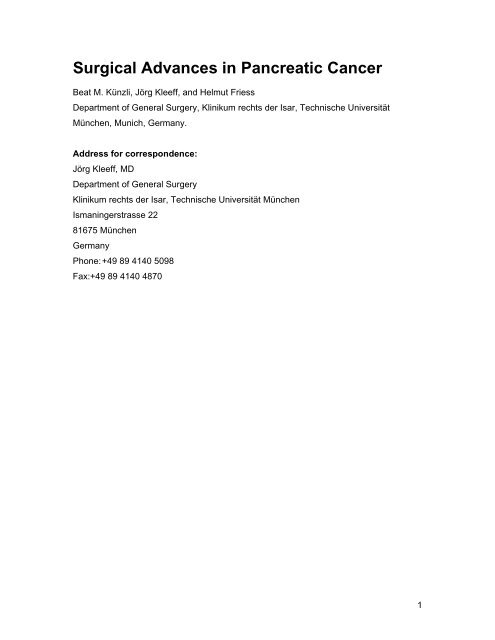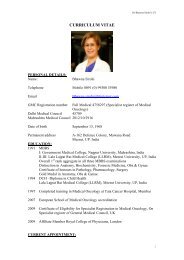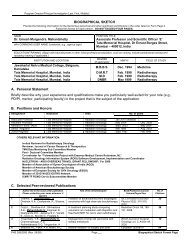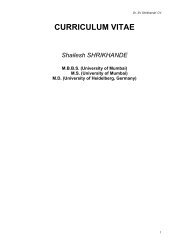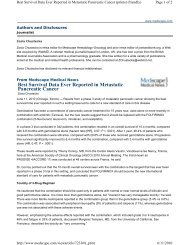Surgical Advances in Pancreatic Cancer- Beat M. Künzli
Surgical Advances in Pancreatic Cancer- Beat M. Künzli
Surgical Advances in Pancreatic Cancer- Beat M. Künzli
Create successful ePaper yourself
Turn your PDF publications into a flip-book with our unique Google optimized e-Paper software.
<strong>Surgical</strong> <strong>Advances</strong> <strong>in</strong> <strong>Pancreatic</strong> <strong>Cancer</strong><br />
<strong>Beat</strong> M. <strong>Künzli</strong>, Jörg Kleeff, and Helmut Friess<br />
Department of General Surgery, Kl<strong>in</strong>ikum rechts der Isar, Technische Universität<br />
München, Munich, Germany.<br />
Address for correspondence:<br />
Jörg Kleeff, MD<br />
Department of General Surgery<br />
Kl<strong>in</strong>ikum rechts der Isar, Technische Universität München<br />
Isman<strong>in</strong>gerstrasse 22<br />
81675 München<br />
Germany<br />
Phone: +49 89 4140 5098<br />
Fax:+49 89 4140 4870<br />
1
Introduction<br />
Despite improvements <strong>in</strong> diagnosis and therapy, pancreatic cancer is still a devastat<strong>in</strong>g<br />
disease, which is presently the fourth lead<strong>in</strong>g cause of cancer related deaths <strong>in</strong> Western<br />
countries. 1 Although significant efforts have been made, only little progress has been<br />
achieved <strong>in</strong> the last decades with respect to the overall survival of pancreatic cancer<br />
patients. It is still a challeng<strong>in</strong>g task to diagnose pancreatic cancer at an early stage that<br />
offers the chance of successful therapy. Thus, the overall resectability rate of pancreatic<br />
cancer is only 10 to 15%. 2 Rapid tumor progression, and a strik<strong>in</strong>g resistance to<br />
chemotherapy, radiotherapy, and targeted/biological therapies 3, 4 contribute to the poor<br />
prognosis. These facts together result <strong>in</strong> low tumor resectability rates after diagnosis,<br />
early tumor recurrence after resection, and poor overall survival rates. Even after<br />
potential curative resection, long term survival is not satisfactory with around 20%, but<br />
subgroup analyses of e.g. lymph node negative tumors that have been resected with<br />
negative marg<strong>in</strong>s demonstrate 5-year survival rates of about 40%. 5 In the last decade<br />
the surgical outcome has improved, mostly because of improv<strong>in</strong>g perioperative<br />
treatment. Birkmeyer et al. 6 demonstrated that operation related morbidity and mortality<br />
significantly decreases <strong>in</strong> centers with high patient load. This critical aspect of the value<br />
of centralization on the outcome of pancreatic surgery <strong>in</strong> “high volume <strong>in</strong>stitutions,” has<br />
been demonstrated <strong>in</strong> numerous studies. 7 The current mortality rate follow<strong>in</strong>g pancreatic<br />
resection is well below 5% 8 <strong>in</strong> specialized surgical centers. Improvements <strong>in</strong> multimodal<br />
therapy 9 comb<strong>in</strong>ed with more experienced surgical treatment of pancreatic cancer at<br />
high volume centers have improved the long-term survival as well as the quality of life of<br />
pancreatic cancer patients.<br />
2
Operations for tumors of the head of the pancreas<br />
Periampullary cancers account for about 5% of all gastro<strong>in</strong>test<strong>in</strong>al tract malignancies, 10<br />
which can be divided <strong>in</strong>to four groups of tumor entities: (i) periampullary tumors that<br />
orig<strong>in</strong>ate from the pancreas (pancreatic cancer), (ii) the mucosa of the ampulla of Vateri<br />
(ampullary carc<strong>in</strong>oma), (iii) the common distal bile duct (distal cholangiocellular<br />
carc<strong>in</strong>oma) or (iv) the mucosa of the duodenum (duodenal adenocarc<strong>in</strong>oma). The most<br />
common periampullary malignancy is pancreatic cancer, account<strong>in</strong>g for 3% of all<br />
gastro<strong>in</strong>test<strong>in</strong>al tumors. Carc<strong>in</strong>oma of the ampulla of Vateri is the second most common<br />
periampullary malignancy 11 . Distal cholangiocellular carc<strong>in</strong>oma is less frequent and<br />
duodenal adenocarc<strong>in</strong>oma of the periampullary region is only rarely seen. 12 The<br />
relatively poor prognosis for periampullary carc<strong>in</strong>omas, exclud<strong>in</strong>g pancreatic head<br />
cancers, with five-year survival rates vary<strong>in</strong>g between 24 and 50%, still rema<strong>in</strong>s a<br />
challenge. 12<br />
One limitation for studies report<strong>in</strong>g on periampullary carc<strong>in</strong>omas, exclud<strong>in</strong>g pancreatic<br />
cancer is that these studies conta<strong>in</strong> only relatively small numbers of study subjects. 11-13<br />
Nevertheless, the standard therapy of choice for all entities of periampullary carc<strong>in</strong>omas<br />
is a partial pancreatoduodenectomy (PD), irrespective of the underly<strong>in</strong>g histology. 12<br />
Despite their low <strong>in</strong>cidence rates, ampullary, cholangiocellular, and duodenal cancers<br />
are attract<strong>in</strong>g attention due to their suspected diverse biological behavior lead<strong>in</strong>g to<br />
improved survival rates <strong>in</strong> comparison to pancreatic cancer. 10, 12 In the next passages of<br />
this chapter, we will focus on the therapy modalities for pancreatic cancer.<br />
The majority of all pancreatic cancers (approximately 60%) arise <strong>in</strong> the head of the<br />
pancreas. In these cases a partial pancreatoduodenectomy (classical Kausch-Whipple<br />
procedure) or a pylorus preserv<strong>in</strong>g pancreatoduodenectomy is considered the gold<br />
standard for surgical therapy. Cameron et al. 5 demonstrated <strong>in</strong> a retrospective review of<br />
1000 pancreaticoduodenectomies- performed by a s<strong>in</strong>gle surgeon- the management and<br />
outcome of these patients. The evolution of this operative procedure was also analyzed<br />
over 5 decades, demonstrat<strong>in</strong>g a significant drop <strong>in</strong> median operative time and <strong>in</strong> the<br />
postoperative hospital stay from <strong>in</strong>itially 17 to 9 days. The mortality rate <strong>in</strong> this series<br />
was 1%. The overall 5-year survival rate was 18%, for the lymph-node negative patients<br />
it <strong>in</strong>creased to 32% and for lymph-node negative patients with negative resection<br />
marg<strong>in</strong>s it reached 41%. 5 This study demonstrates on the basis of a large patient<br />
3
population, how the improvements <strong>in</strong> surgery as well as advances <strong>in</strong> peri and<br />
postoperative care can <strong>in</strong>crease the long term survival rates of patients with pancreatic<br />
cancer treated by pancreatoduodenectomy. This operation has become safe and<br />
effective, with low hospital mortality rates. The question which type of the<br />
pancreatoduodenectomy suits best has been controversially discussed. However,<br />
several randomized controlled studies have been performed, compar<strong>in</strong>g the classical<br />
Kausch-Whipple with the pylorus-preserv<strong>in</strong>g pancreatoduodenectomy.<br />
Classical Kausch-Whipple vs. pylorus preserv<strong>in</strong>g pancreatoduodenectomy (PD)<br />
The classical procedure for operat<strong>in</strong>g on pancreatic head masses was the Kausch-<br />
Whipple operation that consists of the resection of the pancreatic head, the duodenum<br />
along with a distal gastrectomy, cholecystectomy, removal of the distal common bile duct<br />
segment, proximal jejunum, and en-bloc resection of regional lymph nodes. With the re<strong>in</strong>troduction<br />
of the pylorus-preserv<strong>in</strong>g pancreaticoduodenectomy, a modified procedure<br />
without resection of the pylorus and the distal part of the stomach, a controversial debate<br />
on what should be the standard pancreatic head resection had started early. 14 Initial<br />
studies reported a higher <strong>in</strong>cidence of complications, such as delayed gastric empty<strong>in</strong>g<br />
and concerns about less oncological effectiveness of the pylorus-preserv<strong>in</strong>g procedure.<br />
Meanwhile, randomized controlled trials as well as a meta-analysis have demonstrated<br />
that both perioperative morbidity and long-term outcome are equal for the classical<br />
Kausch-Whipple and the pylorus preserv<strong>in</strong>g PD. 15, 16 Even though the question which<br />
procedure should be performed for pancreatic head cancer is not def<strong>in</strong>itively answered,<br />
both procedures can be recommended for resection of cancer aris<strong>in</strong>g <strong>in</strong> the head of the<br />
pancreas, accord<strong>in</strong>g to the most recent available data.<br />
Distal pancreatectomy<br />
Tumors that arise <strong>in</strong> the body or tail of the pancreas can be operated with a distal<br />
pancreatectomy. The distal pancreatectomy consists of the removal of the portion of the<br />
pancreas extend<strong>in</strong>g to the left of the midl<strong>in</strong>e but does not <strong>in</strong>clude resection of the<br />
duodenum and the distal bile duct. The advantage of this procedure, compared to the<br />
PD procedure, is that a pancreatic anastomosis is not needed <strong>in</strong> most cases. Therefore<br />
the distal pancreatectomy has been considered as a simpler surgical procedure <strong>in</strong><br />
4
comparison to a pancreaticoduodenectomy. However, pancreatic fistulas occur <strong>in</strong> 10-<br />
20% of cases and result <strong>in</strong> <strong>in</strong>creased postoperative morbidity, length of hospital stay,<br />
and overall costs. 17 In a recent retrospective study, stapler closure of the pancreatic<br />
remnant has been reported to be associated with significantly higher fistula rates. 18<br />
Therefore, randomized controlled trials have been <strong>in</strong>itiated to identify the best technique<br />
for closure of the pancreatic stump.<br />
Another important aspect of distal pancreatectomy is the often concomitantly performed<br />
splenectomy. Schwarz et al. 19 showed that the median survival of patients undergo<strong>in</strong>g<br />
distal pancreatectomy with curative <strong>in</strong>tention for pancreatic cancer was 17.8 months<br />
without splenectomy and 12.2 months with splenectomy. The en-bloc resection the<br />
spleen was believed to be necessary due to regional lymph nodes and the close relation<br />
of the splenic artery and ve<strong>in</strong> to the body of the pancreas. Hence, splenic preservation<br />
was thought to compromise the oncological resection. Schwarz et al. recommended<br />
therefore that the spleen should be preserved unless the splenic capsule was directly<br />
<strong>in</strong>volved, or nodal clearance required a splenectomy. 19<br />
Total pancreatectomy<br />
In order to improve postoperative outcome, the radical total pancreatectomy has been<br />
<strong>in</strong>troduced to the treatment of pancreatic head cancer. Obviously, this more radical<br />
approach with resect<strong>in</strong>g the whole gland would <strong>in</strong>clude the elim<strong>in</strong>ation of multifocal<br />
disease and complications emanat<strong>in</strong>g from the pancreatic remnant (e.g. pancreatic<br />
fistula). Furthermore, the additional resection of the body and tail of the pancreas would<br />
<strong>in</strong>crease the possibilities for a more extensive lymphadenectomy around the body and<br />
tail of the pancreas as well as tumor resection adjacent to the retroperitoneum. However,<br />
recent studies revealed that the occurrence of multicentric pancreatic cancer is fairly<br />
uncommon, occurr<strong>in</strong>g <strong>in</strong> less than 10% of cases. 20 Moreover, randomized trials on<br />
extended lymphadenectomy showed no significant oncological benefits, especially<br />
because lymph nodes around the body and tail of the gland are rarely <strong>in</strong>volved with<br />
metastatic disease from pancreatic head cancer. In contrast, the removal of the entire<br />
pancreas results <strong>in</strong> severe endocr<strong>in</strong>e and exocr<strong>in</strong>e <strong>in</strong>sufficiency. In terms of studies,<br />
Muller et al. 21 reported that total pancreatectomy had a surgical morbidity of 24% and an<br />
overall mortality rate of 4.8%. The global health status of patients, that have undergone<br />
a total pancreatectomy was after 23 months comparable to that of pylorus preserv<strong>in</strong>g<br />
5
pancreatoduodenectomies, although quality of life (QoL) was reduced. They concluded,<br />
that total pancreatectomy can be a treatment option for selected patients. 21 In<br />
conclusion, total pancreatectomy should not be performed rout<strong>in</strong>ely for pancreatic head<br />
cancer. Rare exceptions may <strong>in</strong>clude tumor extension to the body/ tail of the pancreas<br />
and the presence of an atrophic, soft and friable pancreatic parenchyma for which an<br />
anastomosis is not considered safe.<br />
Venous resection<br />
The specific anatomic position <strong>in</strong> close proximity to the portal ve<strong>in</strong>, the celiac trunk,<br />
superior mesenteric vessels, comb<strong>in</strong>ed with the extensive and aggressive growth<br />
behavior predisposes pancreatic carc<strong>in</strong>oma to affect or even <strong>in</strong>filtrate these structures.<br />
Therefore venous resections were suggested <strong>in</strong> order to obta<strong>in</strong> complete tumor<br />
resections and avoid R1 or even R2 resections. Recent studies <strong>in</strong>dicate that venous<br />
resections can be performed without <strong>in</strong>creased morbidity and mortality. 22 However, data<br />
on long-term survival after venous resection are less clear. A recent systematic review<br />
on portal ve<strong>in</strong> resection reported a median survival of only 13 months follow<strong>in</strong>g<br />
resection. In this study patients were treated from 1965 to 2003 and positive resection<br />
marg<strong>in</strong>s occurred <strong>in</strong> about 40% of cases. 23 Better survival rates have been<br />
demonstrated <strong>in</strong> some s<strong>in</strong>gle center studies. 22 Irrespectively, numerous studies have<br />
shown that partial resection of the portal ve<strong>in</strong>/superior mesenteric ve<strong>in</strong> can be carried<br />
out safely, without the risk of <strong>in</strong>creased morbidity/mortality. In addition, a randomized<br />
multicenter trial compar<strong>in</strong>g resection and radiochemotherapy for locally resectable<br />
<strong>in</strong>vasive pancreatic cancer reported a median survival of >17 months <strong>in</strong> the surgically<br />
treated group versus 11 months <strong>in</strong> the radiochemotherapy arm. 24 These studies together<br />
demonstrate that venous <strong>in</strong>filtration should not be considered a contra<strong>in</strong>dication for<br />
resection <strong>in</strong> pancreatic cancer if a potential curative resection can be achieved. This<br />
strategy has also been adopted <strong>in</strong> current guidel<strong>in</strong>es <strong>in</strong> the USA as well as <strong>in</strong> Europe.<br />
Extended lymphadenectomy<br />
Attempts have been made to decrease the high local recurrence rate follow<strong>in</strong>g<br />
pancreatic cancer resection by perform<strong>in</strong>g a more radical lymph-node dissection. The<br />
rationale for this approach was the observation of affected lymph nodes <strong>in</strong> the paraaortic<br />
6
egion encapsulated between the celiac trunk and the orig<strong>in</strong> of the superior mesenteric<br />
artery. 25 Therefore, the idea to radically operate and remove all these lymph- nodes<br />
seemed to be an appropriate approach. Indeed, <strong>in</strong>itial retrospective studies on extended<br />
radical lymphadenectomy <strong>in</strong> cancer of the pancreatic head reported a survival benefit <strong>in</strong><br />
comparison to standard resection. 26 However randomized controlled trials revealed<br />
different result. In fact, overall morbidity with diarrhea and delayed gastric empty<strong>in</strong>g<br />
tended to occur more frequently after extended lymphadenectomy. A study by Yeo et al.<br />
27<br />
demonstrated comparable mortality and survival rates, whereas morbidity was<br />
significantly <strong>in</strong>creased <strong>in</strong> the extended lymphadenectomy group with <strong>in</strong>creased rates of<br />
postoperative diarrhea and result<strong>in</strong>g malnutrition. 28 This study failed to report differences<br />
<strong>in</strong> 1, 3, and 5-year survival rates. 28 A meta-analysis of standard and extended<br />
lymphadenectomy <strong>in</strong> pancreaticoduodenectomy for pancreatic cancer <strong>in</strong>clud<strong>in</strong>g three of<br />
four randomized controlled trials confirmed the data from Yeo et al. 27 and Farnell et al. 28<br />
<strong>in</strong>dicat<strong>in</strong>g no significant differences between the standard and extended procedure. 29<br />
There were no differences <strong>in</strong> morbidity and mortality rates, with a trend towards higher<br />
<strong>in</strong>cidence of delayed gastric empty<strong>in</strong>g for extended lymphadenectomy. 29 Although the<br />
available randomized studies are underpowered and lack cl<strong>in</strong>ical standardization<br />
regard<strong>in</strong>g the extent of lymphadenectomy, adequate randomized controlled trials that<br />
would be needed to determ<strong>in</strong>e any potential survival benefit, are highly impractical.<br />
Therefore, extended radical lymphadenectomy should not be performed rout<strong>in</strong>ely.<br />
Does R1 resection limits surgical practice?<br />
A key factor for long- term survival of patients with resected pancreatic cancer is a<br />
complete tumor resection with negative resection marg<strong>in</strong>s (R0 resection). Although R0<br />
resection rates have been reported <strong>in</strong> up to 75% <strong>in</strong> large surgical series, most patients<br />
develop local and/or distant recurrences which could be caused by microscopic residual<br />
disease (R1 resection) at the time of resection. Us<strong>in</strong>g new standardized pathological<br />
process<strong>in</strong>g techniques and protocols, a recent study by Esposito et al. 30 displayed R1<br />
resection rates for pancreatic cancer of up to 76%. The most common anatomical site<br />
for evidence of tumor remnants was the posterior marg<strong>in</strong>. In contrast, the R1 resection<br />
rate was 14% (carried out by the same team of surgeons) when no standardized<br />
protocol was used. 30 These results demonstrate the particular need of a thorough and<br />
standardized pathological exam<strong>in</strong>ation of pancreatic cancer specimen, <strong>in</strong> order to allow<br />
7
a precise <strong>in</strong>vestigation and def<strong>in</strong>ition of prognostic relevant histopathological markers.<br />
Furthermore, these data f<strong>in</strong>ally <strong>in</strong>fluence the decision mak<strong>in</strong>g with respect to therapeutic<br />
options such as adjuvant therapy.<br />
Conclusion<br />
In the last decades major pancreatic operations have evolved <strong>in</strong>to safe and standard<br />
surgical procedures. Most progress has been made <strong>in</strong> peri and postoperative practices<br />
and treatment modalities. Therefore, <strong>in</strong> high-volume centers, surgery for pancreatic<br />
cancer is safe with morbidity and mortality rates that are not different from other major<br />
gastro<strong>in</strong>test<strong>in</strong>al surgeries. The 5-year survival has <strong>in</strong>creased to 15%- 25% follow<strong>in</strong>g<br />
resection of pancreatic cancer. However, the notable breakthrough has not yet come<br />
and the overall prognosis of pancreatic cancer has barely changed over the years.<br />
Future studies and potentially multimodal therapies are be<strong>in</strong>g established <strong>in</strong> order to<br />
improve long- term survival of pancreatic cancer patients. Adjuvant chemotherapy with<br />
either 5-FU or gemcitab<strong>in</strong>e has been shown to improve prognosis <strong>in</strong> resectable<br />
pancreatic cancer. Comb<strong>in</strong>ations of chemoradiation and <strong>in</strong>terferon- α as well as novel<br />
biological therapies present promis<strong>in</strong>g future perspectives <strong>in</strong> the treatment of pancreatic<br />
cancer. Extensive surgery should be critically evaluated, extensive/radical<br />
lymphadenectomy has not shown to improve prognosis; however, an isolated portal ve<strong>in</strong><br />
<strong>in</strong>volvement on the other hand does not represent a contra<strong>in</strong>dication for tumor resection.<br />
More extensive surgery on metastatic 31 and recurrent disease 32 rema<strong>in</strong>s questionable,<br />
although some studies seem promis<strong>in</strong>g.<br />
8
References:<br />
1. Jemal A, Siegel R, Ward E, Hao Y, Xu J, Murray T, Thun MJ. <strong>Cancer</strong> statistics,<br />
2008. CA <strong>Cancer</strong> J Cl<strong>in</strong> 2008;58:71-96.<br />
2. Neoptolemos JP, Stocken DD, Dunn JA, Almond J, Beger HG, Pederzoli P,<br />
Bassi C, Dervenis C, Fernandez-Cruz L, Laca<strong>in</strong>e F, Buckels J, Deak<strong>in</strong> M, Adab<br />
FA, Sutton R, Imrie C, Ihse I, Tihanyi T, Olah A, Pedrazzoli S, Spooner D, Kerr<br />
DJ, Friess H, Buchler MW. Influence of resection marg<strong>in</strong>s on survival for patients<br />
with pancreatic cancer treated by adjuvant chemoradiation and/or chemotherapy<br />
<strong>in</strong> the ESPAC-1 randomized controlled trial. Ann Surg 2001;234:758-68.<br />
3. Moore MJ, Goldste<strong>in</strong> D, Hamm J, Figer A, Hecht JR, Gall<strong>in</strong>ger S, Au HJ, Murawa<br />
P, Walde D, Wolff RA, Campos D, Lim R, D<strong>in</strong>g K, Clark G, Voskoglou-Nomikos<br />
T, Ptasynski M, Parulekar W. Erlot<strong>in</strong>ib plus gemcitab<strong>in</strong>e compared with<br />
gemcitab<strong>in</strong>e alone <strong>in</strong> patients with advanced pancreatic cancer: a phase III trial<br />
of the National <strong>Cancer</strong> Institute of Canada Cl<strong>in</strong>ical Trials Group. J Cl<strong>in</strong> Oncol<br />
2007;25:1960-6.<br />
4. Kleeff J, Michalski C, Friess H, Buchler MW. <strong>Pancreatic</strong> cancer: from bench to 5year<br />
survival. Pancreas 2006;33:111-8.<br />
5. Cameron JL, Riall TS, Coleman J, Belcher KA. One thousand consecutive<br />
pancreaticoduodenectomies. Ann Surg 2006;244:10-5.<br />
6. Birkmeyer JD, Stukel TA, Siewers AE, Goodney PP, Wennberg DE, Lucas FL.<br />
Surgeon volume and operative mortality <strong>in</strong> the United States. N Engl J Med<br />
2003;349:2117-27.<br />
7. van Heek NT, Kuhlmann KF, Scholten RJ, de Castro SM, Busch OR, van Gulik<br />
TM, Obertop H, Gouma DJ. Hospital volume and mortality after pancreatic<br />
resection: a systematic review and an evaluation of <strong>in</strong>tervention <strong>in</strong> the<br />
Netherlands. Ann Surg 2005;242:781-8, discussion 788-90.<br />
8. Buchler MW, Wagner M, Schmied BM, Uhl W, Friess H, Z'Graggen K. Changes<br />
<strong>in</strong> morbidity after pancreatic resection: toward the end of completion<br />
pancreatectomy. Arch Surg 2003;138:1310-4; discussion 1315.<br />
9. Kleeff J, Michalski CW, Friess H, Buchler MW. <strong>Surgical</strong> treatment of pancreatic<br />
cancer: the role of adjuvant and multimodal therapies. Eur J Surg Oncol<br />
2007;33:817-23.<br />
10. Sarmiento JM, Nagomey DM, Sarr MG, Farnell MB. Periampullary cancers: are<br />
there differences? Surg Cl<strong>in</strong> North Am 2001;81:543-55.<br />
11. Talam<strong>in</strong>i MA, Moes<strong>in</strong>ger RC, Pitt HA, Sohn TA, Hruban RH, Lillemoe KD, Yeo<br />
CJ, Cameron JL. Adenocarc<strong>in</strong>oma of the ampulla of Vater. A 28-year experience.<br />
Ann Surg 1997;225:590-9; discussion 599-600.<br />
9
12. Berberat PO, Kunzli BM, Gulb<strong>in</strong>as A, Ramanauskas T, Kleeff J, Muller MW,<br />
Wagner M, Friess H, Buchler MW. An audit of outcomes of a series of<br />
periampullary carc<strong>in</strong>omas. Eur J Surg Oncol 2008.<br />
13. de Castro SM, Kuhlmann KF, van Heek NT, Busch OR, Offerhaus GJ, van Gulik<br />
TM, Obertop H, Gouma DJ. Recurrent disease after microscopically radical (R0)<br />
resection of periampullary adenocarc<strong>in</strong>oma <strong>in</strong> patients without adjuvant therapy.<br />
J Gastro<strong>in</strong>test Surg 2004;8:775-84; discussion 784.<br />
14. Traverso LW, Longmire WP, Jr. Preservation of the pylorus <strong>in</strong><br />
pancreaticoduodenectomy. Surg Gynecol Obstet 1978;146:959-62.<br />
15. Smeenk HG, Tran TC, Erdmann J, van Eijck CH, Jeekel J. Survival after surgical<br />
management of pancreatic adenocarc<strong>in</strong>oma: does curative and radical surgery<br />
truly exist? Langenbecks Arch Surg 2005;390:94-103.<br />
16. Diener MK, Knaebel HP, Heukaufer C, Antes G, Buchler MW, Seiler CM. A<br />
systematic review and meta-analysis of pylorus-preserv<strong>in</strong>g versus classical<br />
pancreaticoduodenectomy for surgical treatment of periampullary and pancreatic<br />
carc<strong>in</strong>oma. Ann Surg 2007;245:187-200.<br />
17. Knaebel HP, Diener MK, Wente MN, Buchler MW, Seiler CM. Systematic review<br />
and meta-analysis of technique for closure of the pancreatic remnant after distal<br />
pancreatectomy. Br J Surg 2005;92:539-46.<br />
18. Kleeff J, Diener MK, Z'Graggen K, H<strong>in</strong>z U, Wagner M, Bachmann J, Zehetner J,<br />
Muller MW, Friess H, Buchler MW. Distal pancreatectomy: risk factors for<br />
surgical failure <strong>in</strong> 302 consecutive cases. Ann Surg 2007;245:573-82.<br />
19. Schwarz RE, Harrison LE, Conlon KC, Klimstra DS, Brennan MF. The impact of<br />
splenectomy on outcomes after resection of pancreatic adenocarc<strong>in</strong>oma. J Am<br />
Coll Surg 1999;188:516-21.<br />
20. Karpoff HM, Klimstra DS, Brennan MF, Conlon KC. Results of total<br />
pancreatectomy for adenocarc<strong>in</strong>oma of the pancreas. Arch Surg 2001;136:44-7;<br />
discussion 48.<br />
21. Muller MW, Friess H, Kleeff J, Dahmen R, Wagner M, H<strong>in</strong>z U, Breisch-Girbig D,<br />
Ceyhan GO, Buchler MW. Is there still a role for total pancreatectomy? Ann Surg<br />
2007;246:966-74; discussion 974-5.<br />
22. Hartel M, Niedergethmann M, Farag-Soliman M, Sturm JW, Richter A, Trede M,<br />
Post S. Benefit of venous resection for ductal adenocarc<strong>in</strong>oma of the pancreatic<br />
head. Eur J Surg 2002;168:707-12.<br />
23. Siriwardana HP, Siriwardena AK. Systematic review of outcome of synchronous<br />
portal-superior mesenteric ve<strong>in</strong> resection dur<strong>in</strong>g pancreatectomy for cancer. Br J<br />
Surg 2006;93:662-73.<br />
24. Imamura M, Doi R, Imaizumi T, Funakoshi A, Wakasugi H, Sunamura M, Ogata<br />
Y, Hish<strong>in</strong>uma S, Asano T, Aikou T, Hosotani R, Maetani S. A randomized<br />
multicenter trial compar<strong>in</strong>g resection and radiochemotherapy for resectable<br />
locally <strong>in</strong>vasive pancreatic cancer. Surgery 2004;136:1003-11.<br />
10
25. Nagakawa T, Kobayashi H, Ueno K, Ohta T, Kayahara M, Mori K, Nakano T,<br />
Takeda T, Konishi I, Miyazaki I. The pattern of lymph node <strong>in</strong>volvement <strong>in</strong><br />
carc<strong>in</strong>oma of the head of the pancreas. A histologic study of the surgical f<strong>in</strong>d<strong>in</strong>gs<br />
<strong>in</strong> patients undergo<strong>in</strong>g extensive nodal dissections. Int J Pancreatol 1993;13:15-<br />
22.<br />
26. Manabe T, Ohshio G, Baba N, Miyashita T, Asano N, Tamura K, Yamaki K,<br />
Nonaka A, Tobe T. Radical pancreatectomy for ductal cell carc<strong>in</strong>oma of the head<br />
of the pancreas. <strong>Cancer</strong> 1989;64:1132-7.<br />
27. Yeo CJ, Cameron JL, Lillemoe KD, Sohn TA, Campbell KA, Sauter PK, Coleman<br />
J, Abrams RA, Hruban RH. <strong>Pancreatic</strong>oduodenectomy with or without distal<br />
gastrectomy and extended retroperitoneal lymphadenectomy for periampullary<br />
adenocarc<strong>in</strong>oma, part 2: randomized controlled trial evaluat<strong>in</strong>g survival,<br />
morbidity, and mortality. Ann Surg 2002;236:355-66; discussion 366-8.<br />
28. Farnell MB, Pearson RK, Sarr MG, DiMagno EP, Burgart LJ, Dahl TR, Foster N,<br />
Sargent DJ. A prospective randomized trial compar<strong>in</strong>g standard<br />
pancreatoduodenectomy with pancreatoduodenectomy with extended<br />
lymphadenectomy <strong>in</strong> resectable pancreatic head adenocarc<strong>in</strong>oma. Surgery<br />
2005;138:618-28; discussion 628-30.<br />
29. Michalski CW, Kleeff J, Wente MN, Diener MK, Buchler MW, Friess H.<br />
Systematic review and meta-analysis of standard and extended<br />
lymphadenectomy <strong>in</strong> pancreaticoduodenectomy for pancreatic cancer. Br J Surg<br />
2007;94:265-73.<br />
30. Esposito I, Kleeff J, Bergmann F, Reiser C, Herpel E, Friess H, Schirmacher P,<br />
Buchler MW. Most pancreatic cancer resections are R1 resections. Ann Surg<br />
Oncol 2008;15:1651-60.<br />
31. Shrikhande SV, Kleeff J, Reiser C, Weitz J, H<strong>in</strong>z U, Esposito I, Schmidt J, Friess<br />
H, Buchler MW. <strong>Pancreatic</strong> resection for M1 pancreatic ductal adenocarc<strong>in</strong>oma.<br />
Ann Surg Oncol 2007;14:118-27.<br />
32. Kleeff J, Reiser C, H<strong>in</strong>z U, Bachmann J, Debus J, Jaeger D, Friess H, Buchler<br />
MW. Surgery for recurrent pancreatic ductal adenocarc<strong>in</strong>oma. Ann Surg<br />
2007;245:566-72.<br />
11


